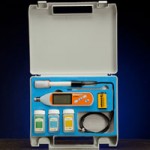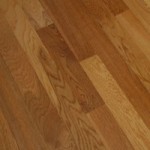
When looking at an architect’s specifications for moisture testing in concrete, it’s most likely that one of two moisture criteria will be indicated – calcium chloride testing (MVER) or relative humidity (RH) testing. If a contractor is familiar with one and not the other, isn’t it a reasonable question to ask if the results of one test method can be converted to meet the alternate spec?
The first stop in this discussion must be to understand that the two tests are very different in both methodology and in the results they provide.
Calcium Chloride Test (MVER) or RH?
The calcium chloride test first appeared in the 1940s as a method of determining if concrete was still wet or not, and was referred to simply as a “dampness test.”
It was solely concerned with the moisture present on the surface of a concrete slab that might impact a flooring installment or adhesive. With no particular scientific method behind the practice, it still became a very commonly used test method in the flooring industry, and calcium chloride test results became known as MVER, or Moisture Vapor Emission Rate.
To conduct a calcium chloride test, a pre-weighed container of calcium chloride (a desiccant) is placed on the concrete surface, and then sealed over with a cover to isolate the test material from ambient conditions.
The test material is then left in place for 72 hours. After the required period of time, the calcium chloride container is then weighed to determine how much moisture was absorbed from the test area.
The basic underlying principle is that as moisture is released from the concrete slab, it will be absorbed by the desiccant, and the change in weight will determine the amount of moisture being released by the slab.
It is not gauged to determine the amount of moisture remaining IN the slab, only what is being released at the surface, to a maximum of no more than ¾”. MVER is expressed in pounds per 1000 square feet.
 There are a number of conditions that have been proven to skew MVER results. High alkalinity must be corrected before testing (pH testing is recommended), and the slab surface condition, cleanliness, or even troweling methods can also impact the MVER results.
There are a number of conditions that have been proven to skew MVER results. High alkalinity must be corrected before testing (pH testing is recommended), and the slab surface condition, cleanliness, or even troweling methods can also impact the MVER results.
The slab must be at service conditions and the type of concrete may also impact testing (calcium chloride testing has been specifically disallowed for lightweight concrete by the ASTM).
Relative humidity testing, or in situ testing, operates by installing sensors, or probes, into holes drilled in the concrete slab to test the moisture conditions at a specific depth in the slab.
As research began in the 1980s into the drying process of concrete and accurate ways to determine what the final moisture content of a concrete slab would be after it had been sealed, it was found that moisture levels in a drying slab were not uniform from top to bottom. Moisture levels tended to be higher near the bottom of the slab and lower near the surface as the moisture evaporated away from the surface. Once the slab is sealed, either with a surface coating or a flooring system, the moisture levels gradually become uniform throughout the slab, a process referred to as equilibration.
Relative humidity testing makes use of sensors that measure the moisture content of concrete at 40% of the slab’s depth (assuming it has been installed with a functional moisture barrier and is drying from one side). At this depth, the moisture content was proven to best indicate the final moisture level of the slab if it were sealed at that point in time.
RH testing also requires that the slab be at service conditions for the best possible results. Not all RH test systems are created equal, but all are designed to measure moisture content internally, where a more accurate indication of the true moisture content can be measured.
Calcium Chloride Tests the Surface
Ultimately, the results expressed as MVER indicate only a qualitative-at-best indication of the presence of free moisture at the surface of the concrete. If you change the surface conditions, the calcium chloride test results can vary greatly without a corresponding change in the internal moisture conditions.
In fact, the ASTM standard F1869 was revised in 2011 to make the surface condition more standardized for testing by defining the treatment of the surface before testing can begin. Ultimately, it is the internal moisture conditions of any concrete slab that will come to have greater importance over the life of the floor. Why?
 As soon as a concrete slab is sealed with an impermeable covering – be it a flooring product or a surface treatment – the moisture content within the slab will not change in quantity, but will continue to transition through the slab in a process called equilibration (assuming an adequate moisture barrier has been installed below).
As soon as a concrete slab is sealed with an impermeable covering – be it a flooring product or a surface treatment – the moisture content within the slab will not change in quantity, but will continue to transition through the slab in a process called equilibration (assuming an adequate moisture barrier has been installed below).
Because moisture exits a drying slab from the surface, it tends to have a more distributed ratio of moisture at the surface and a denser collection of moisture deeper in the slab. As the slab dries, the moisture at the surface evaporates away and more moisture can move up through the pathways of the concrete to the surface, where it too will evaporate away if the ambient conditions are conducive to drying.
Once that surface is sealed, the moisture will eventually reach an evenly-distributed state in the slab. This, by definition, means that a sealed, equilibrated slab will have higher moisture at the surface than it did before it was sealed (when testing happened). Any surface-based test cannot give a true indication of the final, equilibrated moisture levels of a concrete subfloor.
RH testing, on the other hand, does not take readings at the surface, but sensors are placed at a depth scientifically-proven to provide the best indication of the final moisture levels of the slab if it were sealed at that point in time.
Some RH test systems require re-equilibration for each reading, while the Rapid RH® has a unique design that seals the sensor into the slab so that readings are fast and repeatable as often as necessary to monitor the progress of a drying slab.
Therefore, while the surface of the slab may indicate that the slab is ready to receive flooring at that point in time, only RH testing can indicate whether the floor products will be exposed to higher concrete moisture levels over their lifetimes.
Now or Later?
Ultimately, it comes down to the information that a flooring or concrete specialist needs to have to ensure the longevity of the floor system.
IF MVER results have any value, it is in indicating surface conditions of the slab at the moment the test was applied. They may be adequate for a flooring specialist to say, “The MVER is 3 pounds; therefore, the adhesive in the specs can be applied and will hold the flooring today.”
 But what about one month, or one year, down the road?
But what about one month, or one year, down the road?
If the internal moisture level of the slab is high (say 85%, which is not uncommon for a slab that has been rushed through a drying schedule), the amount of moisture the adhesive will be exposed to will continue to rise on a daily basis as the slab equilibrates.
Will the same adhesive be able to hold in the elevated moisture conditions, or will it reach the limits of its moisture tolerance? What will your role be when the call-backs and questions of liability begin?
RH testing, like with the Rapid RH®, indicates what moisture levels of the slab will be then – later on in the life of the floor (and assuming no external changes introduce additional moisture to the slab, like leaking plumbing or a compromised vapor barrier). Its results do not just indicate the surface conditions of a slab, but also accurately determine the end result of moisture conditions within a slab.
At the end of the day, there is no correlation between calcium chloride and RH test results, and trying to find one is to misunderstand the purpose, method, and effectiveness of each test system. The only reasonable alternative is to “convert” to the test method that will support your reputation for installing a long-lasting and durable floor over that concrete slab.




Great article! I am a decorative concrete contractor, a situation I run into is floors in older homes that either do not have a vapor barrier, or a questionable one at best. In those circumstances would one test be better than the other? I have been using calcium chloride tests with the logic that they measure what is actually moving through the concrete but the more I read about moisture testing it seems neither test is designed for that purpose.
Jason:
Thanks for the question. Most people smarter than I would say that if you KNOW there isn’t a vapor retarder, then you should be planning your project as if the moisture levels within the slab are at their highest. This is due to the variability of moisture that will inevitably be introduced to the slab, via the soil, due to the lack of retarder underneath. This planning would include some type of moisture mitigation protection on the surface of the slab rated to maximum moisture levels. Now, if you don’t KNOW whether there is a vapor retarder, then viewing the RH%, in the concrete, will give you a better idea of the potential for moisture-related issues after the finish installation compared to MVER which is only telling you what is going on right now on the very surface of the concrete.
Jason
Hi Jason, I just did a Calcium Chloride Test. Weight gain was 4 grams. Time was 65.5 hours. Per manual calculations, it shows 6.7. Per online calculator (for Calcium Chloride Tests) shows 7.19. We want to install LVP on top of the concrete. Currently, there is carpeting with a pad. We live in Orange County, California (if location matters). Is 6.7 or 7.19 acceptable for Concrete with LVP? Or should we consider Red Gard (or some equivalent). Thanks, Eric
Eric:
Thanks for the question. You really need to consult the LVP and/or adhesive manufacture guidelines for this to ensure proper levels are obtained. Good luck.